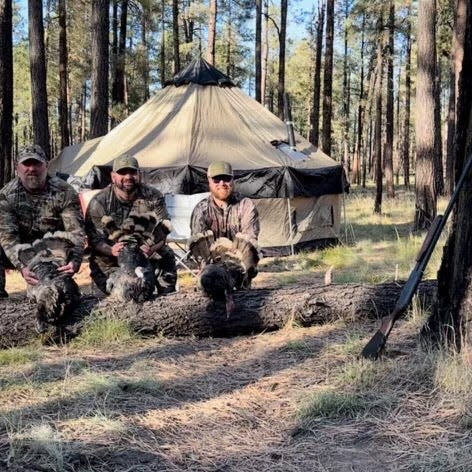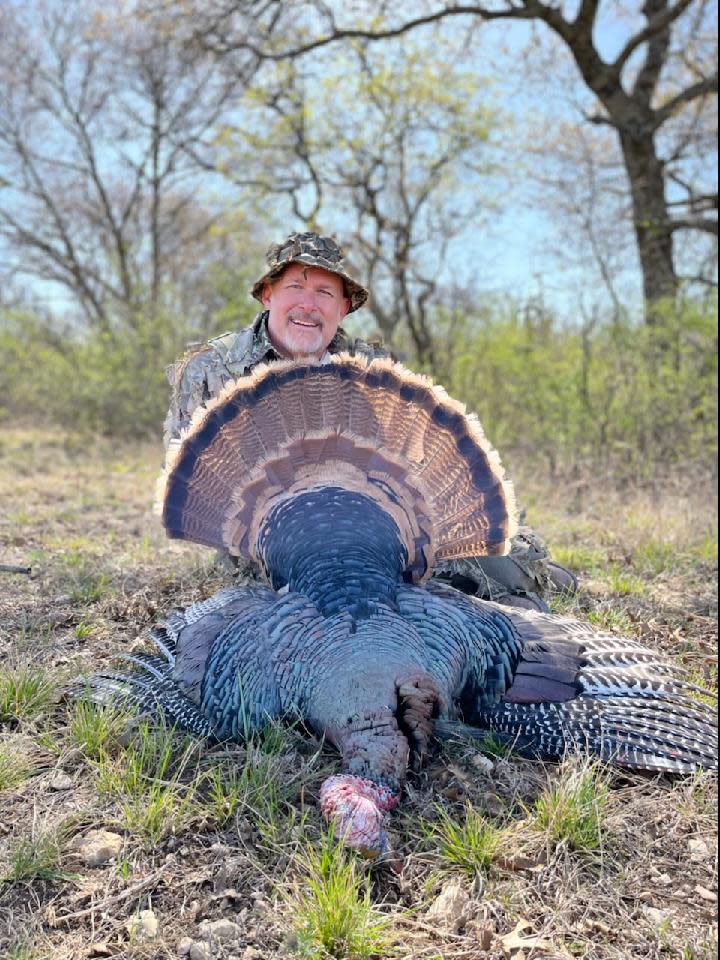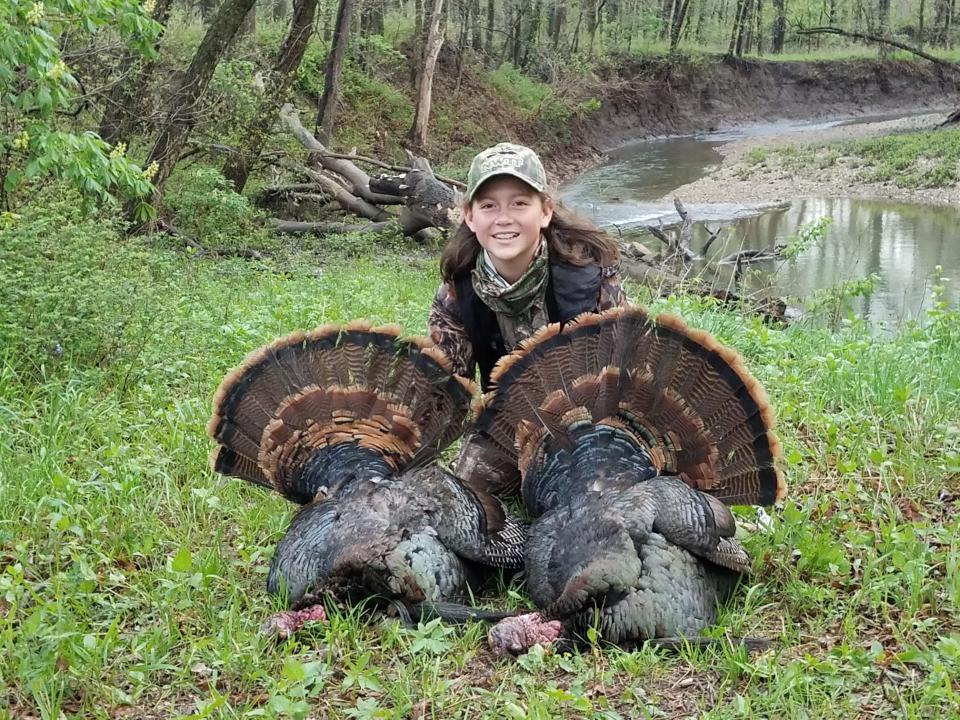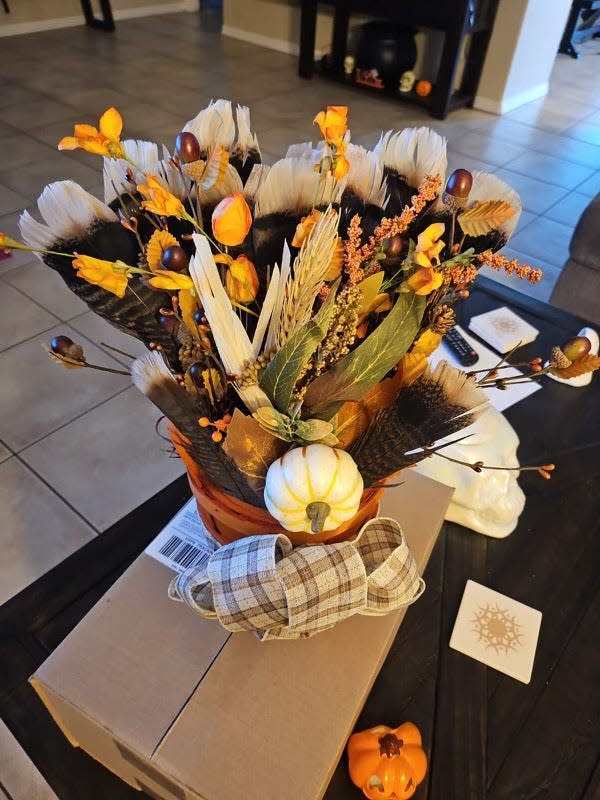Forget the grocery store. These Arizona hunters bag their Thanksgiving turkey in the wild
Chris Villescas wouldn’t describe himself as a huge turkey fan.
He eats it once a year on Thanksgiving. Maybe as deli meat in a sandwich. It's not his favorite.
But since he took up hunting a few years ago, he had wondered on occasion, even remarked to his wife: Wouldn’t it be cool to eat a turkey I hunted for Thanksgiving?
A self-described novice hunter, Villescas got into it through his friend and coworker Nate Bartlett, an outdoors enthusiast who was after hunting buddies. Another colleague, Matt Bartlett, who is not related to Nate, made it a trio.
They called themselves the B Team Hunting Club, and set out seeking wild turkey. But they kept going home empty-handed. The turkeys weren’t so much avoiding their shots as avoiding them.
“During turkey season, we had never even seen a turkey,” Villescas said.
Still, they had faith. That one day, a wild bird would cross their path. That they would take a shot, and hit. And then, crucially, call their wives with the good news.
“I think at some point in time they were starting to think that maybe we weren't hunting turkeys, and we're doing something else,” Villescas said. “Because we never come home with one.”
So as cooler weather fell across Arizona this year, the B Team Hunting Club reassembled.
On Oct. 5, they drove east from Phoenix, almost all the way to the state line, stopping in a pocket of the Apache-Sitgreaves National Forests known to hunters by another name: Game Management Unit 27.
The hunt was on.
Why is Thanksgiving so expensive? Here's what the data says
Putting a turkey on the table is no easy task
Roasting a Thanksgiving turkey requires planning.
Fresh or frozen? Organic and local, or picked up from the grocery store? Should I pre-order? What if they run out? Do we want big, huge or colossal? How much will it cost? And, wait, isn’t cousin Anne a vegetarian now?
But for Arizonans who load their table with wild turkey, the planning starts even sooner.
Hunting seasons are not dictated by holidays, and so even if turkey hunting was easy — more on that later — it’s not as simple as going out to shoot one the week of Thanksgiving.
Wild turkeys roam Arizona, though in smaller numbers than in midwestern and southern states. They can be found gobbling in the White Mountains, roosting in the Chiricahuas, and foraging in the Prescott National Forest.

Arizona is home to three subspecies: Merriam’s, partial to ponderosa pines and by far the state’s largest population; Gould’s, found in the Sky Islands in the state’s southeast corner; and Rio Grande turkeys in the Arizona Strip by the Utah border.
All three can be hunted, but there are rules in place to ensure a sustainable population.
First, you need a valid hunting license and a tag, hunting lingo for a permit to legally harvest an animal. You can only hunt between certain dates, one turkey season in the spring and one in the fall, only in certain areas, and only using a shotgun shooting shot or a bow, no rifles or handguns allowed. And you can only kill one turkey per calendar year.
In 2023, across spring and fall shotgun seasons combined, the Arizona Game and Fish Department issued 8,631 tags.
But as the B Team Hunting Club knows well, a tag doesn’t guarantee a turkey.
Hunting turkey is a game of patience
“You know, people talk about turkeys being dumb,” said Brian Wooldridge.
“I always joke — who’s dumber? The turkey, or the person that gets up at three in the morning and dresses like a bush to outsmart a turkey?”
Wooldridge has had almost 40 years to think about it.
He grew up in Iowa, and began hunting at age 12, accompanying his father to the woods in the early hours of the morning. He would sit, sometimes fidgeting a little too much for his dad’s liking, and witness the woods come to life: hooting owls, deer and coyotes passing by, the soft gobble of male turkeys (known as toms) on the roost.
Now 50, and the president of the northern Arizona chapter of the National Wild Turkey Federation, Wooldridge has never lost his adolescent sense of awe.

“For me, the first time I hear a bird gobble, it’s the same as when I was 12 years old,” he said. “That’s never changed in all those years.”
Turkey hunting, Wooldridge said, is a game of patience. They have brains the size of peas, but excellent eyesight, and an almost uncanny ability to detect when the vibes are off.
He has known birds to flee from unconvincing decoys, to sprint at the sight of lime-green piping on a child’s hunting garb. They may not be smart, but they are highly instinctual.
“Anything that does not look right or sound right and they will leave,” he said.
According to Wooldridge, there’s no such thing as a typical turkey hunt. But in the spring, it tends to look something like this: He gets up early, around 3 a.m. He drives, and then hikes, to the site of the hunt, camouflaged from head to toe. He sets up decoy turkeys, the woods still shrouded in darkness.
Pumpkin pie or apple? A state-by-state guide to people's favorite Thanksgiving pies
And then he calls to the birds, mimicking the sound of a female turkey, or hen, in the hope of luring a tom.
He starts out soft, when the birds are still on the roost. Once they fly to the ground, he calls more aggressively.
Wooldridge is a biologist who has spent his career working in wildlife management and conservation, though he spoke to The Republic in a personal capacity.
He said this method of calling, a fake hen luring a real tom, is challenging because it runs against how turkeys have evolved. It’s done this way because you can’t shoot hens in the spring, when they are breeding.
“So you're trying to call this male into you, when naturally in the wild, they find a place and they strut and they gobble and they lure the hens,” he said.
There are other pitfalls. Sometimes a hunter’s call will attract a predator like a coyote, scaring the tom away. Sometimes the tom will leave with a real hen. Sometimes they just don’t respond, for reasons of their own.
“And if it doesn't work, then you get up and you go find the next bird gobbling,” Wooldridge said. “You know, you just keep moving.”
It’s a different game in the fall, when turkeys aren’t breeding. But Wooldridge prefers the spring, the thrill of calling back and forth with a gobbling tom.
“When I was a kid, we used to always get our turkeys in the spring and save them for Thanksgiving dinner,” he said. “That was always part of the family tradition.”
First light, and the hunt is on
On Oct. 6, Villescas and his friends rose before first light.
The night prior, before setting up camp, they had stopped in at a bar in the small town of Alpine. There, a local told them about some spots to check out, where they might find turkeys.
“We've had that happen before, where locals would tell us where to go,” Villescas said. “And of course, there's never any animals there.”
But none of them had ever hunted Unit 27 before, only scouting it out virtually the week before. So they decided to give the local advice a go. They drove to the spot he suggested and parked their vehicles.
“And a turkey literally flew right in front of our trucks,” Villescas said.
A gunshot rang out through the forest. Someone, not far away, had nabbed a bird.
Finally, things were looking up.

The trio kept exploring, trying out different trails, acquainting themselves with the unit. As they passed by a watering hole, the truck trundling along, Villescas thought he spotted something. His friends did too.
“We both look at each other like, ‘Was that — was that a turkey?’” he said. “We slam the brakes, pull over, and we realize that if it was, they were at the base of the hill and there's no way we're going to be fast enough in our age and shape to chase down a running turkey.”
They strategized, and decided to climb up the hill from the opposite direction and come down at the turkeys.
They split up, spanning out for safety as Nate, the more experienced hunter, went ahead. With an eye on the turkeys, he took a shot. He hit it.
He yelled out to the rest of the B Team the direction the turkeys were running.
Villescas and Matt took their shots. Both hit. That was three. They had somehow managed to bag their turkeys at the exact same time.
"From the same exact group of turkeys,” Villescas said. “For all three of us, it was the first time we had ever successfully hunted a turkey.”
They celebrated. Took pictures. And they made that call to their wives.
Making holiday traditions old and new
The last time Wooldridge and his family had a wild turkey for Thanksgiving, it was a special bird: the first one hunted by his daughter, Sydney.
She had started hunting at age 10, but went a few seasons in Arizona without filling a tag. Then she won a competition through the National Wild Turkey Federation for an all-expenses paid turkey hunt in Kansas.
It was a spring hunt, in April 2017, and Sydney was 12. She missed a few shots on the first day, Wooldridge said, and worked with her instructor to correct her technique.
The next morning, within 30 minutes of daybreak, she had two birds on the ground.
“I was so proud of her,” Wooldridge said.
The very first bird Sydney shot had two beards, an uncommon feature in toms that some hunters pursue for a lifetime.
“And the best part of it was, she didn't realize what she'd done,” he said. “I was like, ‘Wow, you shot a double bearded tom.’ And she was like, ‘What's that mean?’”
That turkey spent a couple of years in the freezer before the family enjoyed it for Thanksgiving.
It meant a lot to Wooldridge, reminding him not only of that proud day in Kansas, but also of how he and his daughter were able to bond over hunting, in the same way he did with his own father.
And, he said, there’s something about putting your own food on the table.
“Knowing that somebody in the family is putting good, wholesome, organic food in the freezer is an amazing feeling,” he said. “I would much rather eat deer and elk than beef.”
To him, wild turkey tastes a little different than farm-raised birds, but not a whole lot. They’re not as plump or moist, he said, so brining is an essential step.
In recent years, Wooldridge’s family has taken to grinding up their wild turkeys, using the meat for burgers and tacos and lasagna instead
But next year, he hopes to shoot a few birds during the Texas spring season, and save one for Thanksgiving dinner.
“I want to go back to that if we can,” he said.
Villescas is hoping to start a new tradition. His turkey is in the freezer, plucked and shrink-wrapped and ready to go. Almost.

“I don't know the weight,” Villescas said. “I know that the cooking time is based on the turkey's weight, but when you buy a turkey, it just tells you what the weight is. So I need to weigh this thing.”
Wild turkeys are smaller than farm-raised birds, but the one Villescas shot should be enough for his family of four.
“The funny thing is, my parents wanted to come over and I was like, ‘Listen, I want to be honest,’” Villescas said. “‘These birds are not as big as they are in the store. There's not that much turkey. I don't know how far this turkey is going to go.’”
However much it weighs, the turkey is shaping up to be a big part of Thanksgiving. Villescas’s wife has fashioned a centerpiece for the table using its feathers.
“We’re excited to see how it tastes,” he said. “Never had a wild turkey.”
He already has a tag for next spring.
This article originally appeared on Arizona Republic: How some Arizona hunters bag their Thanksgiving turkey in the wilds

